
The Spyderco Poliwog features a 2 5/16" drop point blade made of VG10 stainless steel. The knife has an overall length of 5 5/8", is 3 3/8" when closed, and has an ambidextrous Ball Bearing lock. The handle is made from stainless steel and the entire knife weighs 4.1 ounces. The wire fame clip is reversible front to back.
From the Spyderco webpage on the Poliwog :
A pollywog represents metamorphosis in the animal kingdom, adapting and changing its form to survive in its environment. The same principle applies here. The Spyderco Poliwog CLIPIT thrives in a small-knife-friendly environment while keeping the features necessary to excel in a harsh, heavy cutting and performance setting. Its distinctive opened-ended Ball Bearing Lock™ exposes the knife’s inner workings for easy cleaning and rates as one of Spyderco’s highest strength locking mechanisms. Pulling back on the ball unlocks the blade ambidextrously from either side of the knife. The hand settles on the curved handle positioning the index finger into a choil that optimizes control and generates less fatigue and pressure on the hand during cutting. Made from VG-10, the blade has a hollow-ground edge with a weight reducing swedge-grind extending mid-spine to the tip. It is available PlainEdged. Its ambidextrous wire-tension pocket clip sets the Poliwog tip-up in the pocket.
A shot alongside the UK Pen knife and D'Allara :

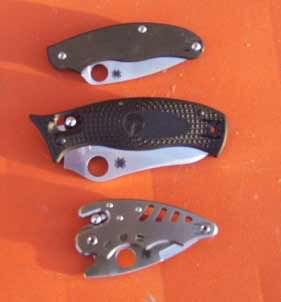
While the blade looks really side when closed, this is mainly an optical distortion due to to the shortness of the knife and the top "horn" of the ball lock, which does however make the profile symmetric. It actually measures just 10% larger than the paramilitary in the same region (1.64" vs 1.85").
The knife is ground from 1/8" stock with a hollow primary grind which tapes to a fine and acute edge, between 0.014-0.020" thick at ~12-14 degrees per side. The knife easily shaved NIB and could readily push cut photocopy paper.
A few quick tests which allow a decent perspective of blade performance.
On thread the Poliwog knife took 94 (10) grams to make a cut and 0.80 (15) cm of edge to cut light cutton under a 200 g load. Very sharp in general as expected from the shaving, but a little lower than average for Spyderco in regards to slicing aggression.
The knife cuts well, slices through 3/8" hemp taking 19 (1) lbs to make a cut on push with a slight reduction to 16 (1) lbs on a slice.
The Poliwog achieved 130 (7) pages on a 50 lbs press into a phonebook showing solid point penetration, no heavy stabbing could be done due to problems with grip security in an incepick grip.
After the stock testing the blade was used in a variety of ways to get a feel for its scope of work, round out the stock testing profile and examine aspects of long term use.
In the kitchen the handle shape is a little odd for most tasks, for some tasks like peeling potatoes a three fingered grip was used with the index finger free and around the side of the blade and often the thumb used as a pinch grip for control :
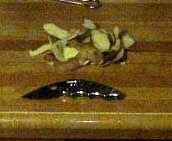
It also easily cut fresh tomatoes, which does not require any specific geometry just that the edge be very sharp :
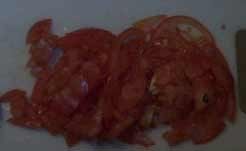
It also works fine for dicing small vegetables chunking up potatoes easily :
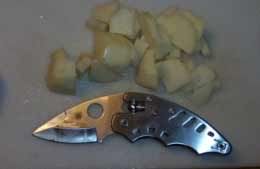
and carrots :
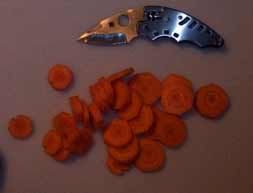
However it can crack carrots if they are split lengthwise, and making straight cuts is difficult due to the wedging forces. Specifically it takes about six lbs to dice up a medium carrot with the Poliwog compared to just about one for a optomized kitchen utility knife.
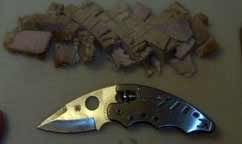
It can still do various utility tasks such as breaking down a cooked chicken, breaking down the tips :
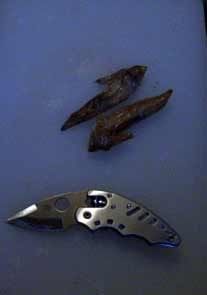
as well as chunking up the meat :
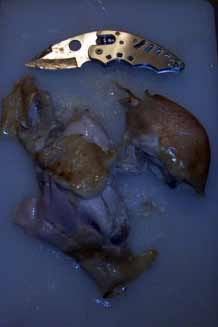
The small blade length does raise the chance that the pivot will need cleaning and in general the Poliwog lacks the length to work as a fine slicer on both large cuts of meat or bigger vegetables.
The steel was also easily corrosion resistant enough to prevent any oxidization from being an issue without excessive care been taken to keep the blade rinsed and dry.
The first real task was to cut a lot of hardwood, a few hundred slices were made into a piece of birch flooring. The main purposes were to give a quick check on initial edge stability but more importantly to check ergonomics. Surprisingly there was no issue with the pinky in the end cutout which is often a problem with smallish grips mainly because the full curve allowed the force to be applied readily and naturally to the apex.
There were no immediate hot spots and after the cutting there was only minor discomfort due to the ends of the top part of the ball lock recess being a bit less than optimally contoured and this tends to sink into the fleshy part between the thumb and forefinger, this can easily be fixed by the user with some sandpaper or a few minutes with a dremel.
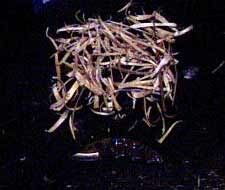
As for edge retention, the knife went from being able to push cut light paper readily to requiring a draw, and with a few passes on CrO loaded leather was back to smoothly push cutting photocopy paper with no need of even a hint of a draw. VG-10 is a solid performer for stainless in many aspects of edge retention and this one is no exception.
The edge while fine and acute by Spyderco standards is still robust enough to handle such tasks as cutting CAT-5 cable :

As a general utility tool, the Poliwog has a fine point enhanced by the swedge which functions well for precision work, as a general tool, moving beyond knife use, it lacks the robustness of designs like the D'Allara or Manix which are more purpose driven and far more rugged blades. Despite its rather unique nature though it isn't limited function wise more so than designs like the UK Pen knife, though the UK has in general a more ergonomic and secure grip.
The Poliwog was used to cut up some ridged 1/8" carboard, the performance was similar to other blades seen in the past, more wear resistant steels like S30V can outperform it significantly, but it does fairly well if after every few dozen cuts it is lightly stropped, and the performance cen be further enhanced by lowering the grit of the edge finish. The edge retention of VG-10 is solid for stainless, significant work was done with the Spyderco Temperance in this regard. The Poliwog seems similar based on the qualitaive comparison noted previously.
The steel used in the Poliwog, VG-10, generally gets solid praise for ease of sharpening, specifically in taking a very sharp edge, this is enhanced by the very the thin and acute edge on the Poliwog.
The Poliwog's Ball Lock was stable under light to moderate spine whacks (dent pine readily to about a mm) under varying speeds, white knuckling doesn't seem to be able to load the lock and torques are not an issue either. It was a bit grating to close at first, but cycling the lock rapidly towards the end of the close smoothed it out significantly.
There are some general concerns with grips due to the nature of the handle, sabre and hammer holds work fine :
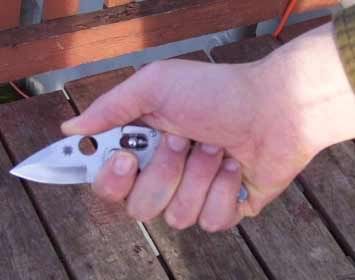
as does a reverse grip
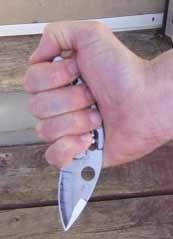
However an icepick grip is a problem, the handle simply doesn't sit well and security is very low, thus it is near impossible to do a hard jackhammer like stab unless reverse grip is used and the wrist tilted back at an angle to keep the force compressive on the lock.
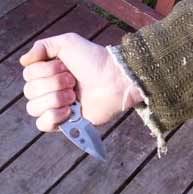
One of the blades strongest aspects is the actual rather "funky" appearance, it is one of the most friendly knives to present to non-knife people as it has a high gadget appeal and it has a very nice symmetric flow with graceful curves rather than sharp tactical corners and black blades and G10 grips. In this regards the three screws around the lock are a less than symmetric (though likely chosen for functionality) and the rectangular cutouts would look better if they curved the other way.
In short, though this looks to be a knife designed primarily for visual appeal (it seemed that way to me anyway), there is a strong sense of function from the ergonomics of the smooth curvature which fits the hand well, to the well designed primary profile and efficient edge design. While grips are somewhat limited due to the finger grooves, the knife performs well over a fairly broad range of tasks and VG-10 gives solid edge retention and responds well to sharpening.
Comments can be emailed using cliffstamp[REMOVE]@cutleryscience.com or by posting in the following thread on Bladeforums :
More information can be obtain at the Spyderco website.
| Last updated : | |
| Originally written: | 11 : 20 : 2005 |